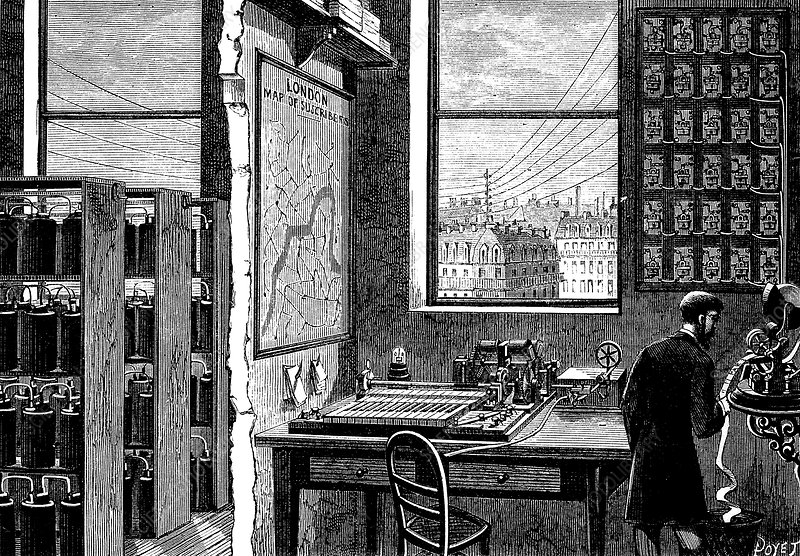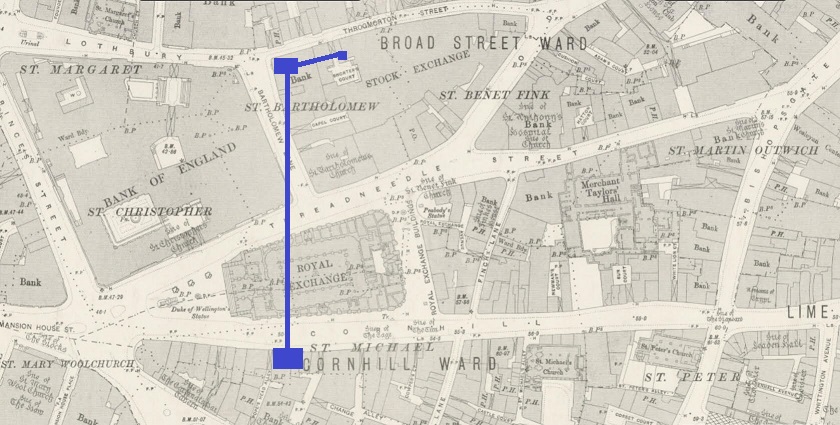A (long) Friday financial history thread for fintwit. It& #39;s one of my favorite historical examples of how the material infrastructures of finance matter: a pre-history of HFT if you will. And I just had to cut it from my dissertation, so wanted to share.
In 1872, the Exchange Telegraph Company, otherwise known as Extel, began its ticker tape service for the London Stock Exchange. But Extel could not actually do most of its work from the floor of the exchange. Space was needed for batteries and circuits that wasn& #39;t available.
So, Extel had one telegrapher on the trading floor who sent prices to Extel& #39;s HQ in Cornhill, from where they were transmitted to the whole system. Note 3 things in this pic: the batteries to the left, the circuit switchboard on the right, and the wires seen through the window
The wires running between the stock exchange & Extel were the lifeblood of the ticker tape system. The rooftop of the Royal Exchange, over which the wires had to pass, became some of the most valuable airspace in Victorian London. By 1884, Extel had over 60 wires on this route.
But other telecoms companies also needed that airspace for wires. And so the roof of the Royal Exchange became was a jumble of wires and cables belonging to numerous different telegraph and telephone co& #39;s, fighting for space on a limited number of poles & wayleaves.
The jumble of wires was organized largely through the use of "guard wires." Strong, iron wires that didn& #39;t carry electrical charge, that protected & separated the wires of one company from the wires of another that shared the same pole. This system actually worked pretty well.
Until, of course it didn& #39;t. Especially when rival companies were assigned space on the same set of poles and wayleaves: like Extel & the United Telephone Company. Extel believed that the use of telephones would make the "tape but an auxiliary," in the provision of financial info.
Thus, the wayleave over the Royal Exchange that Extel shared with the United Telephone co became a contentious site of politics as both companies struggled for space on the wayleave to expand the material infrastructures of their business.
Extel was at a distinct disadvantage because they were on the *bottom* half of the pole. The United Telephone co. had substantially more space to add wires up the pole, but Extel did not. Extel& #39;s space was strictly limited by the location of the United& #39;s wires.
When Extel began asking United for more pole space, United responded by "pre-emptorily refusing to accede," and in fact, erected *more* guard wires "underneath their own...to prevent the wires of (Extel) from being raised" b/c they knew Extel was trying to expand.
What& #39;s more, the guard wires United erected frequently got loose and fell on Extel& #39;s wires, interrupting the ticker tape service. When Extel& #39;s engineers arrived, they cut the guard wires away. The United Co simply re-erected them back in the same place a few days later.
In June of 1884, the United tried an even more aggressive tactic. Instead of running their guard wires parallel and above Extel& #39;s on the pole, they erected a guard wire that ran perpendicularly across Extel& #39;s wires and were "placed in actual contact," with them.
United& #39;s new guard wire was pressed Extel& #39;s down, causing a chain reaction as every wire in Extel& #39;s part of the pole was forced down on the one below it, "deranging their action and preventing the transmission of messages."
As soon as they figured it, out Extel& #39;s engineers cut away United& #39;s new guard wire, and erected more of their own. Extel& #39;s guard wires were in the usual space (parallel to & not touching United& #39;s wires). They just erected more of them in hopes of preventing anymore malfeasance.
This led to yet more infrastructural reprisals from United. The next day, United& #39;s workmen cut away all of Extel& #39;s guard wires, and then even went so far as to tie a new guard wire (of United& #39;s) down on top of Extel& #39;s wires *again*.
The new United guard wire did not immediately disrupt Extel& #39;s service, so Extel wasn& #39;t aware that had been put up. They only found out after it rained when the cotton that covered the guard wire got wet and fell onto Extel& #39;s active wires, yet again causing massive disruptions.
Upon inspection, Extel also found that the guard wire had begun slowly chafing and cutting through Extel& #39;s active wires. But the United Telephone Co still refused to remove the guard wire because it was merely "protecting" its space on the pole
The dispute was only resolved after Extel took United to court and got legal relief.
There& #39;s a lot to say about the whole incident but the big takeaway is how such small and detailed technicalities, like where wires were located on telegraph pole, had deep and real consequences for financial markets. Technical details are never just technical details.
Infrastructural control over flows of financial information was (and remains) a key way institutions and firms influence how financial markets and who had power over them. Fin.

 Read on Twitter
Read on Twitter



